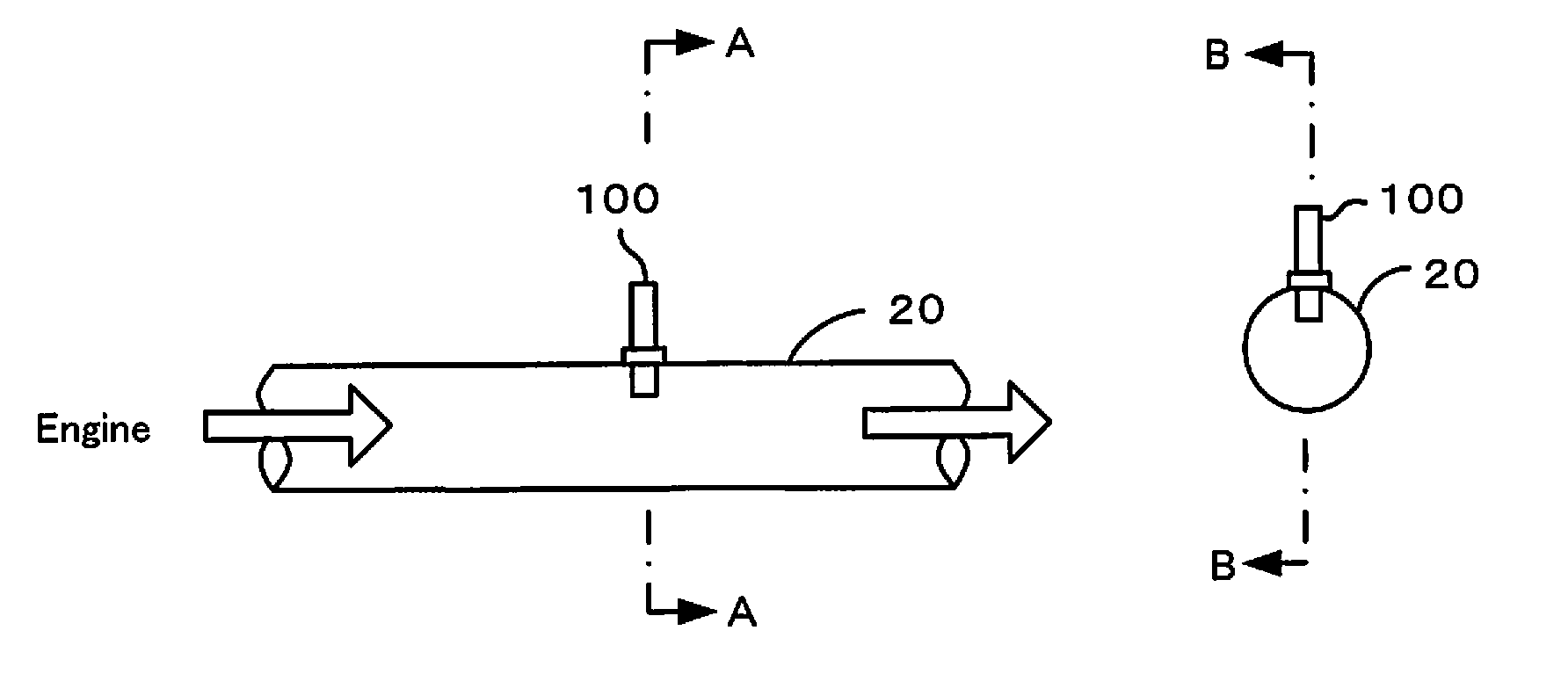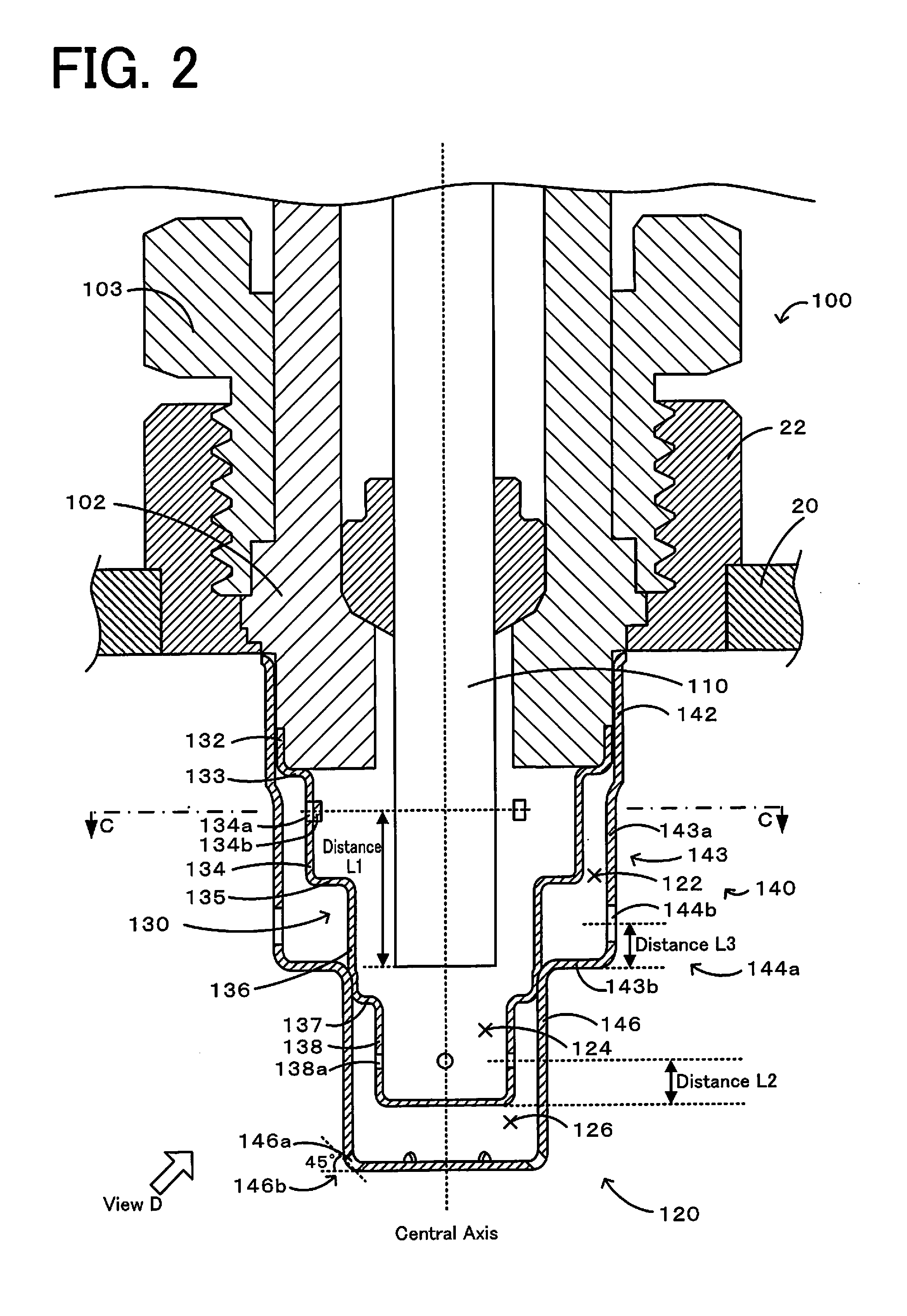Gas sensor
a technology of gas sensor and sensor element, which is applied in the direction of instruments, structural/machine measurement, material analysis, etc., can solve the problems of decreasing the time required for the measured gas to reach the sensor element, so as to increase the responsiveness of the gas concentration detection process, prevent the reduction of the sensitivity of the detection of the sensor element, and increase the power consumption
- Summary
- Abstract
- Description
- Claims
- Application Information
AI Technical Summary
Benefits of technology
Problems solved by technology
Method used
Image
Examples
experimental example 1
[0089]The gas sensor 100 illustrated in FIGS. 2 to 12 serves as Experimental Example 1. More specifically, the inner protection cover 130 is 0.3 mm in thickness and is 17.7 mm in length in the axial direction. The large-diameter portion 132 is 1.8 mm in length in the axial direction. The first body portion 134 is 5.4 mm in length in the axial direction. The second body portion 136 is 5.6 mm in length in the axial direction. The tip end portion 138 is 4.9 mm in length in the axial direction. The external diameter of the large-diameter portion 132 is 14.1 mm. The external diameter of the first body portion 134 is 11.8 mm. The external diameter of the second body portion 136 is 8.2 mm. The external diameter of the tip end portion 138 is 5.9 mm. The first-inner-hole count Nin of the first inner gas holes 134a is 3. The first-inner-hole average area Ain is 0.200 mm2. The distance L1 is 6 mm. The first-inner-hole non-existence maximum angle θinmax is 115°. The formed angle θ1 is 38°. The ...
experimental examples 2 to 12
[0090]Experimental Examples 2 to 11 are configured by changing the values of the first-outer-hole count Nout, the first-inner-hole count Nin, the inner / outer hole count ratio Nr, the first-outer-hole average area Aout, the first-inner-hole average area Ain, the inner / outer hole-area ratio Ar, the horizontal hole non-existence maximum angle θhmax, the vertical hole non-existence maximum angle θvmax, the first-outer-hole non-existence maximum angle θoutmax, the first-inner-hole non-existence maximum angle θinmax, and the distance L1 of the gas sensor of Experimental Example 1 to those indicated by Table 1. More specifically, Experimental Example 2 is configured as follow. That is, the shape of the inner protection cover is changed into the shape of the inner protection cover 230 of the gas censor 200 illustrated in FIGS. 13 and 14. The first-inner-hole count Nin=6. The inner / outer hole count ratio Nr=0.5. The first-inner-hole non-existence maximum angle θinmax=55°. The other values ar...
experimental examples 12 to 13
[0097]The following gas sensor is configured as Experimental Example 12. That is, all the 12 first outer gas holes are horizontal holes. The other values are the same as those of Experimental Example 2. In addition, the following gas sensor is configured as Experimental Example 13. That is, all the 12 first outer gas holes are the vertical holes. The other values are the same as those of Experimental Example 2. FIGS. 20 and 21 are cross-sectional views illustrating the arrangement of the first inner gas holes and the first outer gas holes of Experimental Examples 12 and 13, respectively. Table 2 shows the first-outer-hole count Nout, the number of horizontal holes, and the number of vertical holes of Experimental Examples 2, 12, and 13. Note that in Experimental Examples 12 and 13, the first inner gas holes are formed at equal intervals, and the first outer gas holes are formed at equal intervals.
[0098][Evaluation Test 2]
[0099]A test that is the same as the evaluation test 1 was con...
PUM
| Property | Measurement | Unit |
|---|---|---|
| area | aaaaa | aaaaa |
| area | aaaaa | aaaaa |
| area | aaaaa | aaaaa |
Abstract
Description
Claims
Application Information
 Login to View More
Login to View More - R&D
- Intellectual Property
- Life Sciences
- Materials
- Tech Scout
- Unparalleled Data Quality
- Higher Quality Content
- 60% Fewer Hallucinations
Browse by: Latest US Patents, China's latest patents, Technical Efficacy Thesaurus, Application Domain, Technology Topic, Popular Technical Reports.
© 2025 PatSnap. All rights reserved.Legal|Privacy policy|Modern Slavery Act Transparency Statement|Sitemap|About US| Contact US: help@patsnap.com



